Seismic Imaging of Complex Velocity Structures by 2D Pseudo-Viscoelastic Time-Domain Full-Waveform Inversion
Abstract
1. Introduction
2. Problem Statement
3. Theory
3.1. Forward problem
3.2. Inverse Problem
4. Synthetic Data Example
5. Results
6. Conclusions
Author Contributions
Funding
Institutional Review Board Statement
Informed Consent Statement
Data Availability Statement
Conflicts of Interest
References
- Al-Ali, M.N.; Verschuur, D.J. An integrated method for resolving the seismic complex near-surface problem. Geophys. Prospect. 2006, 54, 739–750. [Google Scholar] [CrossRef]
- Soleimani, M. Challenges of seismic imaging in complex media around Iran, from Zagros overthrust in the southwest to Gorgan Plain in the northeast. Lead. Edge 2017, 36, 499–506. [Google Scholar] [CrossRef]
- Wittkamp, F.; Athanasopoulos, N.; Bohlen, T. Individual and joint 2-D elastic full-waveform inversion of Rayleigh and Love waves. Geophys. J. Int. 2019, 216, 350–364. [Google Scholar] [CrossRef]
- Soleimani, M. Seismic image enhancement of mud volcano bearing complex structure by the CDS method, a case study in SE of the Caspian Sea shoreline. Russ. Geol. Geophys. 2016, 57, 1757–1768. [Google Scholar] [CrossRef]
- Soleimani, M. Naturally fractured hydrocarbon reservoir simulation by elastic fractures modeling. Petrol. Sci. 2017, 14, 286–301. [Google Scholar] [CrossRef]
- Pan, Y.; Gao, L.; Bohlen, T. Time-domain full-waveform inversion of Rayleigh and Love waves in presence of free-surface topography. J. Appl. Geophys. 2018, 152, 77–85. [Google Scholar] [CrossRef]
- Ravaut, C.; Operto, S.; Improta, L.; Virieux, J.; Herrero, A.; Dell’Aversana, P. Multiscale imaging of complex structures from multifold wide-aperture seismic data by frequency-domain full-waveform tomography: Application to a thrust belt. Geophys. J. Int. 2004, 159, 1032–1056. [Google Scholar] [CrossRef]
- Brossier, R. Seismic imaging of complex structures by 2D elastic frequency-domain full-waveform inversion. Geophysics 2009, 74, WCC63–WCC76. [Google Scholar] [CrossRef]
- Singh, S.; Kanli, A.I.; Mukhopadhyay, S. Full waveform inversion in time and frequency domain of velocity modeling in seismic imaging: FWISIMAT a Matlab code. Earth Sci. Res. J. 2018, 22, 291–300. [Google Scholar] [CrossRef]
- Tarantola, A. A strategy for nonlinear inversion of seismic reflection data. Geophysics 1986, 51, 1893–1903. [Google Scholar] [CrossRef]
- Soleimani, M. Seismic imaging by 3D partial CDS method in complex media. J. Pet. Sci. Eng. 2016, 143, 54–64. [Google Scholar] [CrossRef]
- Choi, Y.; Shin, C. Frequency-domain elastic full waveform inversion using the new pseudo-Hessian matrix: Experience of elastic Marmousi 2 synthetic data. Bull. Seismol. Soc. Am. 2008, 98, 2402–2415. [Google Scholar] [CrossRef]
- Martin, G.S.; Wiley, R.; Marfurt, K.J. Marmousi2: An elastic upgrade for Marmousi. Lead. Edge 2006, 25, 156–166. [Google Scholar] [CrossRef]
- Choi, Y.; Min, D.; Shin, C. Two-dimensional waveform inversion of multi-component data in acoustic elastic coupled media. Geophys. Prospect. 2008, 56, 863–881. [Google Scholar] [CrossRef]
- Brossier, R.; Virieux, J.; Operto, S. Parsimonious finite-volume frequency-domain method for 2-D P-SV-wave modelling. Geophys. J. Int. 2008, 175, 541–559. [Google Scholar] [CrossRef]
- Thiel, N.; Bohlen, T. 2d Acoustic Full Waveform Inversion of Submarine Salt Layer Using Dual Sensor Streamer Data; Annual WIT Report; Annual WIT: Hamburg, Germany, 2016. [Google Scholar]
- Brossier, R. Two-dimensional frequency-domain visco-elastic full waveform inversion: Parallel algorithms, optimization and performance. Comput. Geosci. 2011, 37, 444–455. [Google Scholar] [CrossRef]
- Kurzmann, A.; Gaßner, L.; Shigapov, R.; Thiel, N.; Athanasopoulos, N.; Bohlen, T.; Steinweg, T. Real data applications of seismic full waveform inversion. In High Performance Computing in Science and Engineering’17; Springer: Cham, Switzerland, 2018; pp. 467–484. [Google Scholar]
- Gao, L.; Pan, Y.; Bohlen, T. 2-D multiparameter viscoelastic shallow-seismic full-waveform inversion: Reconstruction tests and first field-data application. Geophys. J. Int. 2020, 222, 560–571. [Google Scholar] [CrossRef]
- Groos, L.; Schäfer, M.; Forbriger, T.; Bohlen, T. The role of attenuation in 2D full-waveform inversion of shallow-seismic body and Rayleigh waves. Geophysics 2014, 79, R247–R261. [Google Scholar] [CrossRef]
- Groos, L.; Schäfer, M.; Forbriger, T.; Bohlen, T. Application of a complete workflow for 2D elastic full-waveform inversion to recorded shallow-seismic Rayleigh waves. Geophysics 2017, 82, R109–R117. [Google Scholar] [CrossRef]
- Bohlen, T.; Wittkamp, F. Three-dimensional viscoelastic time-domain finite-difference seismic modelling using the staggered Adams–Bashforth time integrator. Geophys. J. Int. 2016, 204, 1781–1788. [Google Scholar] [CrossRef][Green Version]
- Butzer, S.; Kurzmann, A.; Bohlen, T. 3D elastic full-waveform inversion of small scale heterogeneities in transmission geometry. Geophys. Prospect. 2013, 61, 1238–1251. [Google Scholar] [CrossRef]
- Jetschny, S.; Bohlen, T.; Kurzmann, A. Seismic prediction of geological structures ahead of the tunnel using tunnel surface waves. Geophys. Prospect. 2011, 59, 934–946. [Google Scholar] [CrossRef]
- Robertsson, J.O.; Levander, A.; Symes, W.W.; Holliger, K. A Comparative Study of Free-Surface Boundary Conditions for Finite-Difference Simulation of Elastic/Viscoelastic Wave Propagation. In SEG Technical Program Expanded Abstracts; SEG library: Houston, TX, USA, 1995; pp. 1277–1280. [Google Scholar]
- Blanch, J.O.; Robertsson, J.O.A.; Symes, W.W. Modeling of a constant Q: Methodology and algorithm for an efficient and optimally inexpensive viscoelastic technique. Geophysics 1995, 60, 176–184. [Google Scholar] [CrossRef]
- Bohlen, T. Parallel 3-D viscoelastic finite difference seismic modeling. Comput. Geosci. 2002, 28, 887–899. [Google Scholar] [CrossRef]
- Groos, L. 2D Full Waveform Inversion of Shallow Seismic Rayleigh Waves. Ph.D Thesis, Karlsruher Institut für Technologie (KIT), Karlsruhe, Germany, 2013. [Google Scholar]
- Komatitsch, D.; Martin, R. An unsplit convolutional perfectly matched layer improved at grazing incidence for the seismic wave equation. Geophysics 2007, 72, SM155–SM167. [Google Scholar] [CrossRef]
- Martin, R.; Komatitsch, D. An unsplit convolutional perfectly matched layer technique improved at grazing incidence for the viscoelastic wave equation. Geophys. J. Int. 2009, 179, 333–344. [Google Scholar] [CrossRef]
- Choi, Y.; Alkhalifah, T. Application of multi-source waveform inversion to marine streamer data using the global correlation norm. Geophys. Prospect. 2012, 60, 748–758. [Google Scholar] [CrossRef]
- Köhn, D. Time Domain 2D Elastic Full Waveform Tomography. Ph.D. Thesis, Christian-Albrechts-Universität zu Kiel, Kiel, Germany, 2011. [Google Scholar]
- Sourbier, F.; Operto, S.; Virieux, J.; Amestoy, P.; L’Excellent, J.Y. FWT2D: A massively parallel program for frequency-domain full-waveform tomography of wide-aperture seismic data—Part 1: Algorithm. Comput. Geosci. 2009, 35, 487–495. [Google Scholar] [CrossRef]
- Sourbier, F.; Operto, S.; Virieux, J.; Amestoy, P.; L’Excellent, J.Y. FWT2D: A massively parallel program for frequency-domain full-waveform tomography of wide-aperture seismic data—Part 2: Numerical examples and scalability analysis. Comput. Geosci. 2009, 35, 496–514. [Google Scholar] [CrossRef]
- Brossier, R. Imagerie Sismique à deux Dimensions des Milieux Visco-Élastiques par Inversion des Formes D’ondes: Développements Méthodologiques et Applications. Ph.D. Thesis, Université Nice Sophia Antipolis, Nice, France, 2009. [Google Scholar]
- Soleimani, M.; Rafie, M. Imaging of seismic data in complex structures by introducing the partial diffraction surface stack method. Studia Geophys. Geod. 2016, 60, 644–661. [Google Scholar] [CrossRef]
- Mora, P. Nonlinear two-dimensional elastic inversion of multioffset seismic data. Geophysics 1987, 52, 1211–1228. [Google Scholar] [CrossRef]
- Tarantola, A. Theoretical background for the inversion of seismic waveforms, including elasticity and attenuation. Pure Appl. Geophys. 1988, 128, 365–399. [Google Scholar] [CrossRef]
- Plessix, R.E.; Mulder, W.A. Frequency-domain finite-difference amplitude-preserving migration. Geophys. J. Int. 2004, 157, 975–987. [Google Scholar] [CrossRef]
- Bunks, C.; Saleck, F.M.; Zaleski, S.; Chavent, G. Multiscale seismic wave-form inversion. Geophysics 1995, 60, 1457–1473. [Google Scholar] [CrossRef]
- Kamberis, E.; Kokinou, E.; Koci, F.; Lioni, K.; Alves, T.M.; Velaj, T. Triassic evaporites and the structural architecture of the External Hellenides and Albanides (SE Europe): Controls on the petroleum and geoenergy systems of Greece and Albania. Int. J. Earth Sci. 2022, 111, 789–821. [Google Scholar] [CrossRef]
- Roure, F.; Andriessen, P.; Callot, J.P.; Faure, J.L.; Ferket, H.; Gonzales, E.; Guilhaumou, N.; Lacombe, O.; Malandain, J.; Sassi, W.; et al. The Use of Palaeo-Thermo-Barometers and Coupled Thermal, Fluid Flow and Pore-Fluid Pressure Modelling for Hydrocarbon and Reservoir Prediction in Fold and Thrust Belts; Book chapter; Geological Society Publications: London, UK, 2010; Volume 348. [Google Scholar]
- Socco, L.V.; Foti, S.; Boiero, D. Surface-wave analysis for building near-surface velocity models -Established approaches and new perspectives. Geophysics 2010, 75, 75A83–75A102. [Google Scholar] [CrossRef]
- Athanasopoulos, N.; Manukyan, E.; Bohlen, T.; Maurer, H. Accurate reconstruction of shallow P-wave velocity model with time-windowed elastic full-waveform inversion. In Proceedings of the 80th EAGE Conference and Exhibition 2018, Copenhagen, Denmark, 11–14 June 2018; pp. 1–5. [Google Scholar]
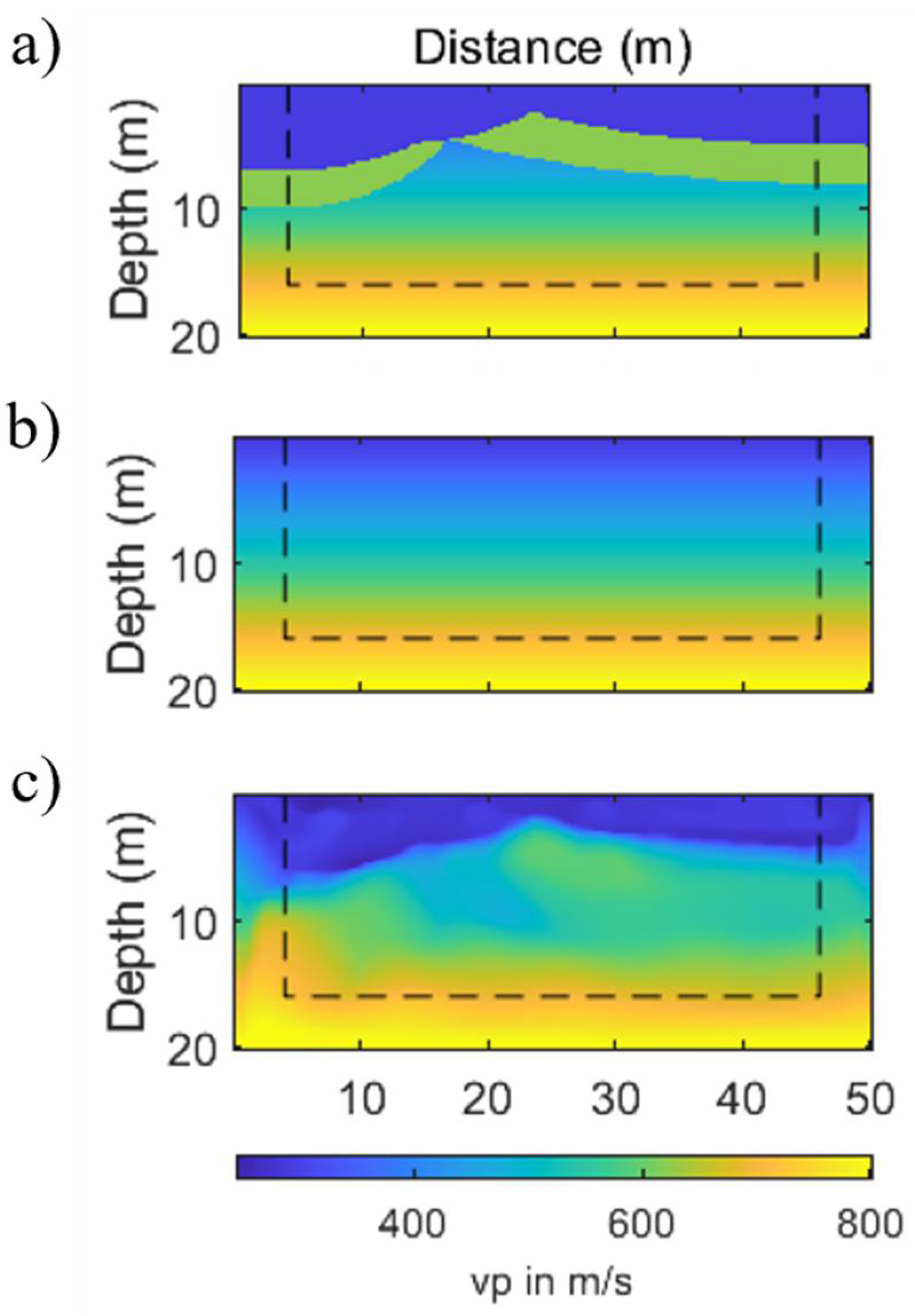
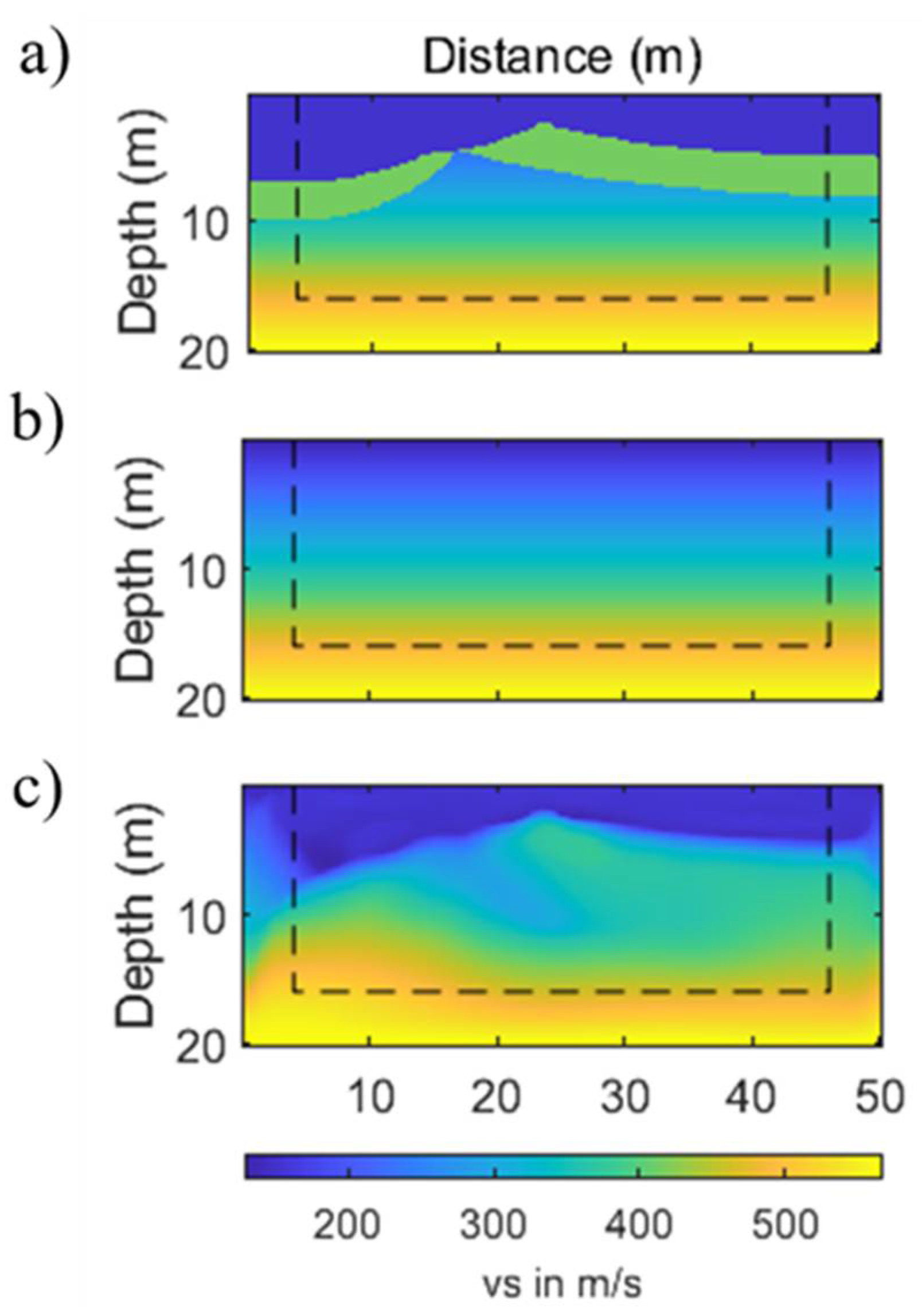
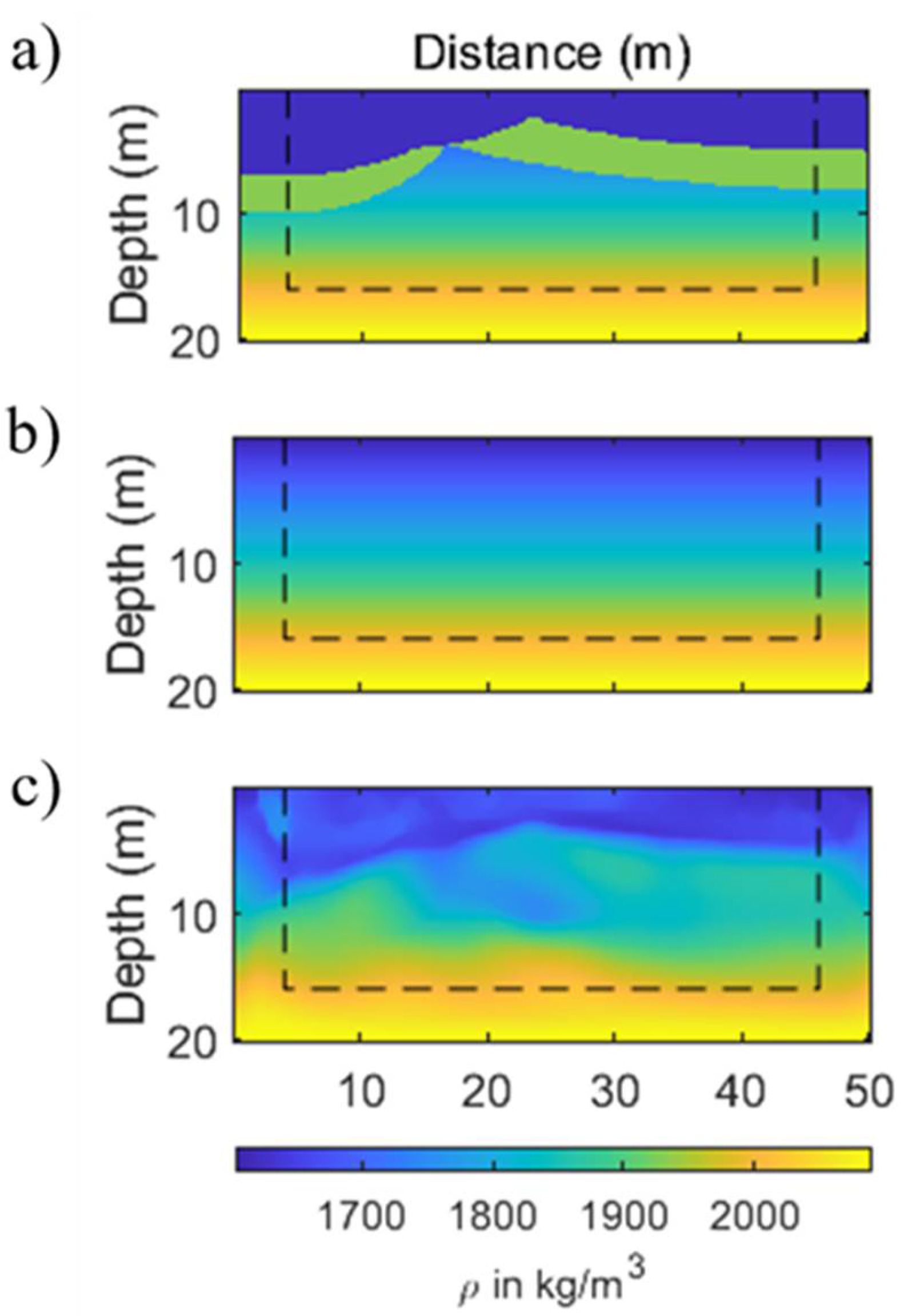
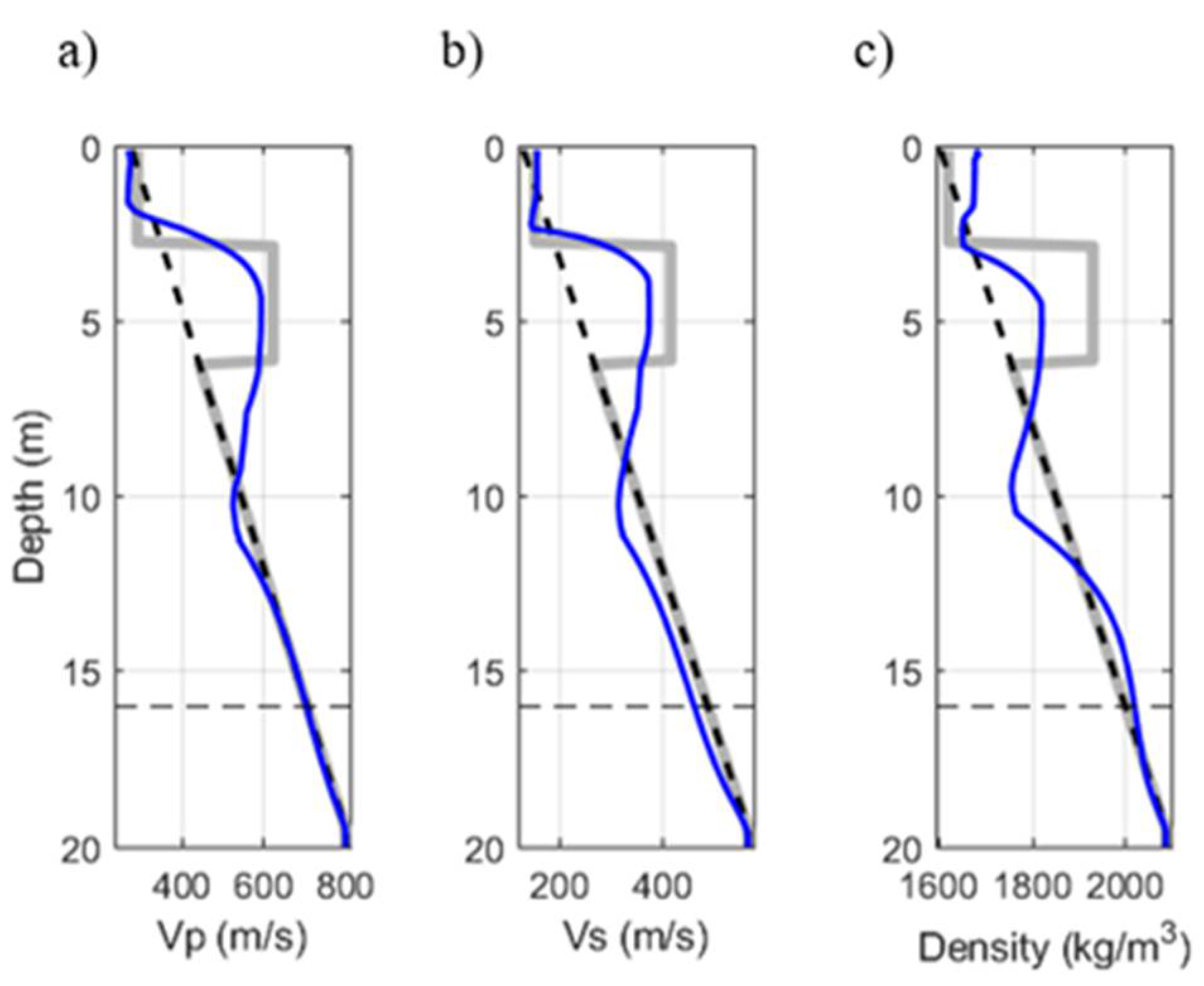

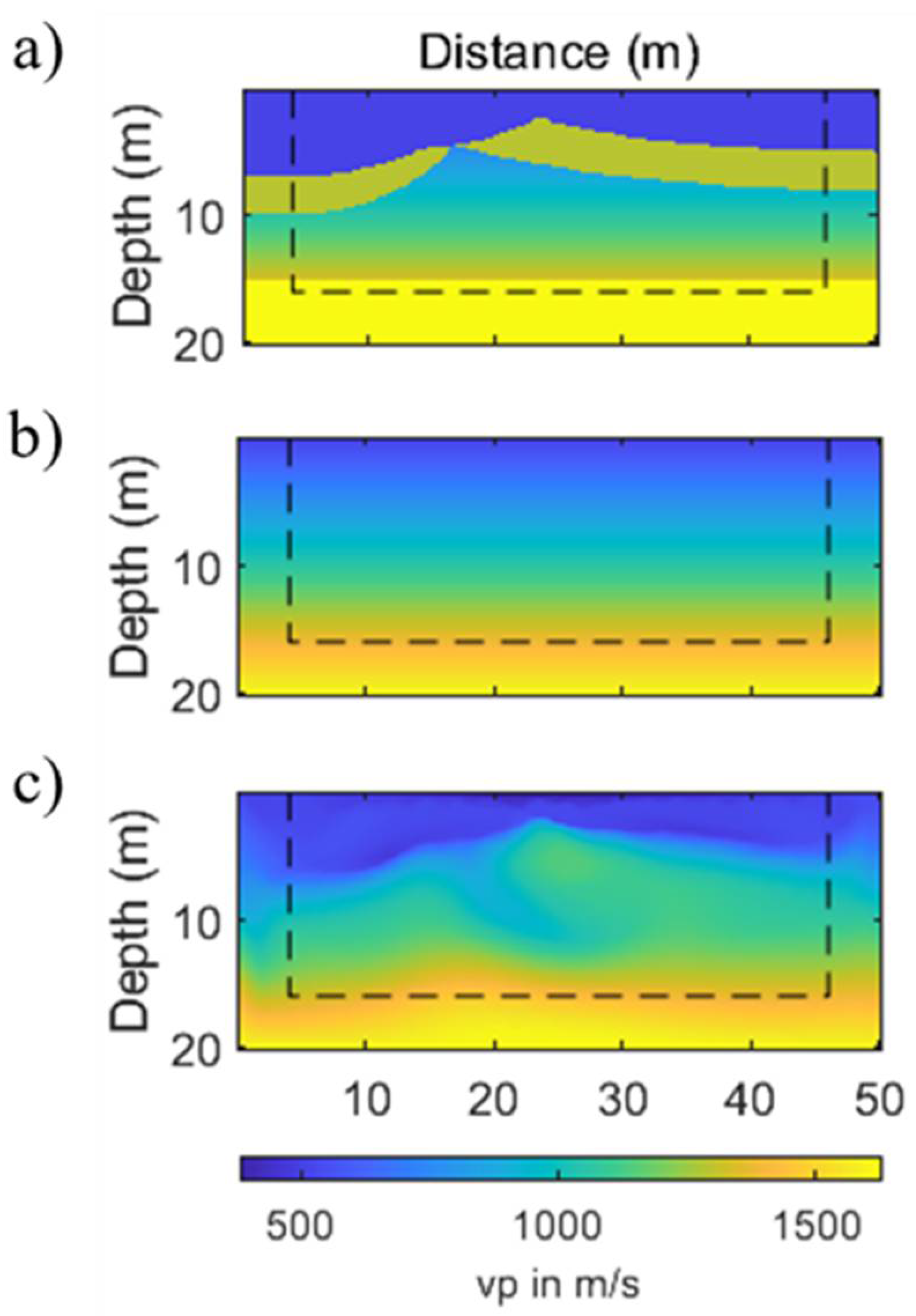

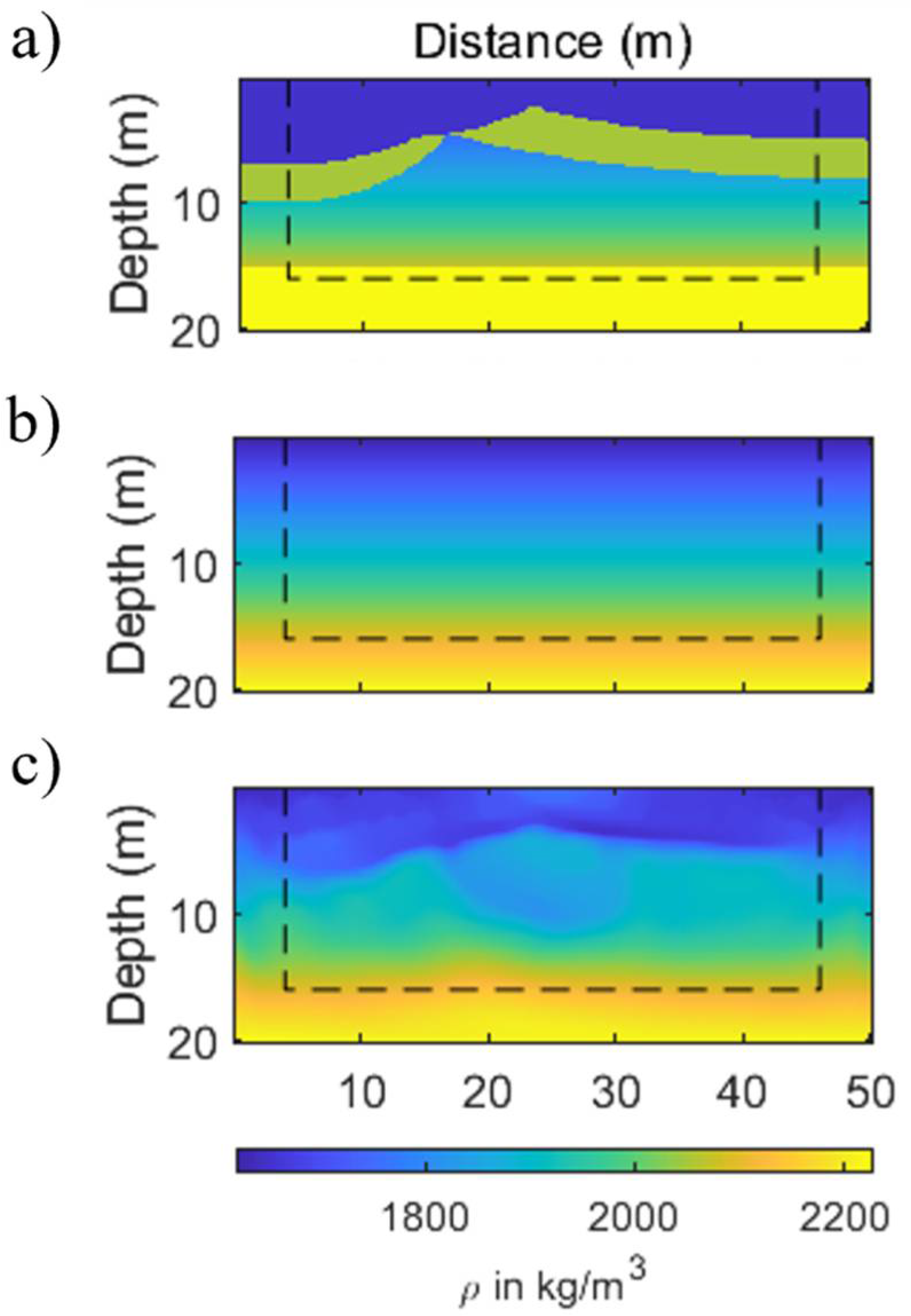
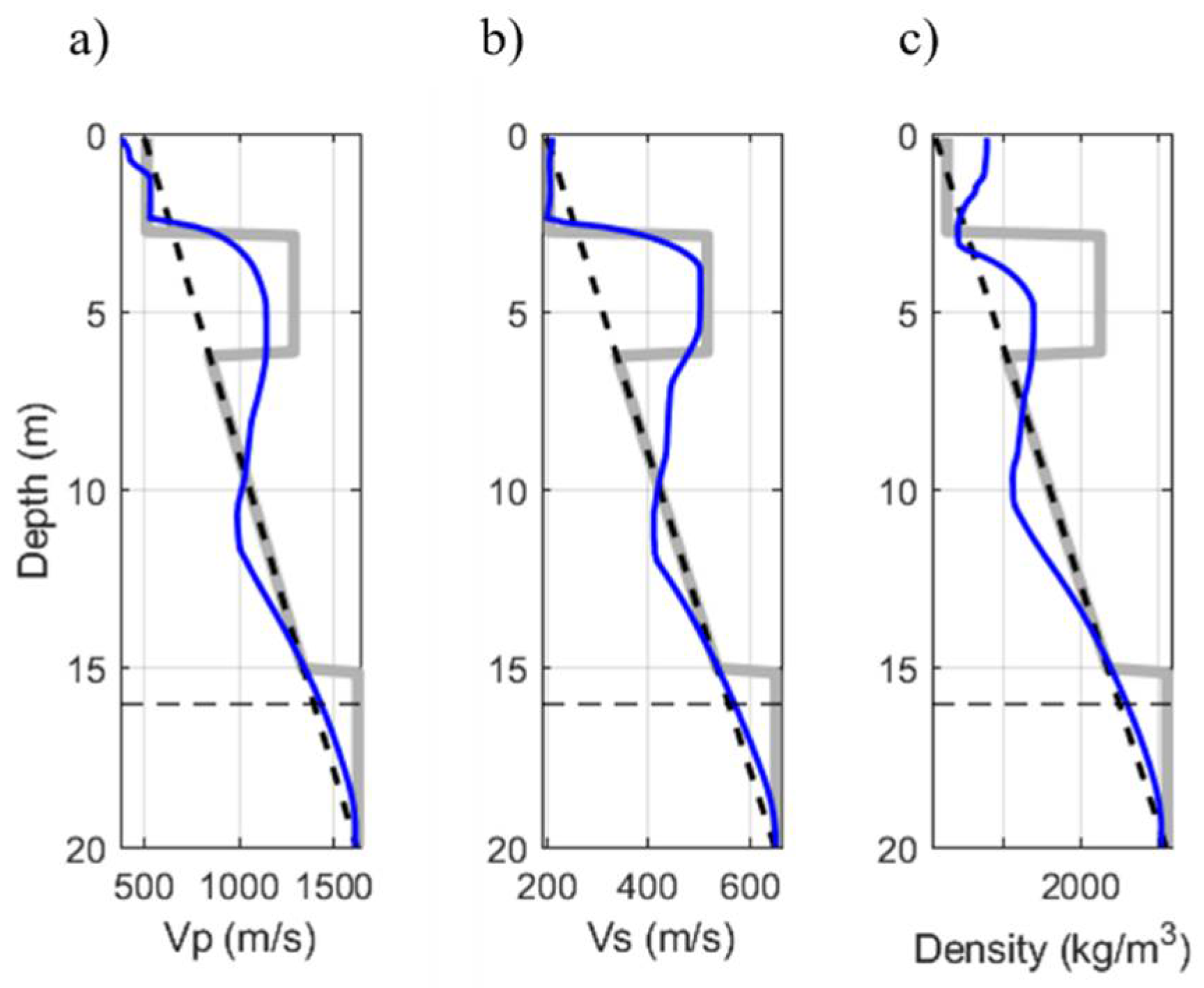
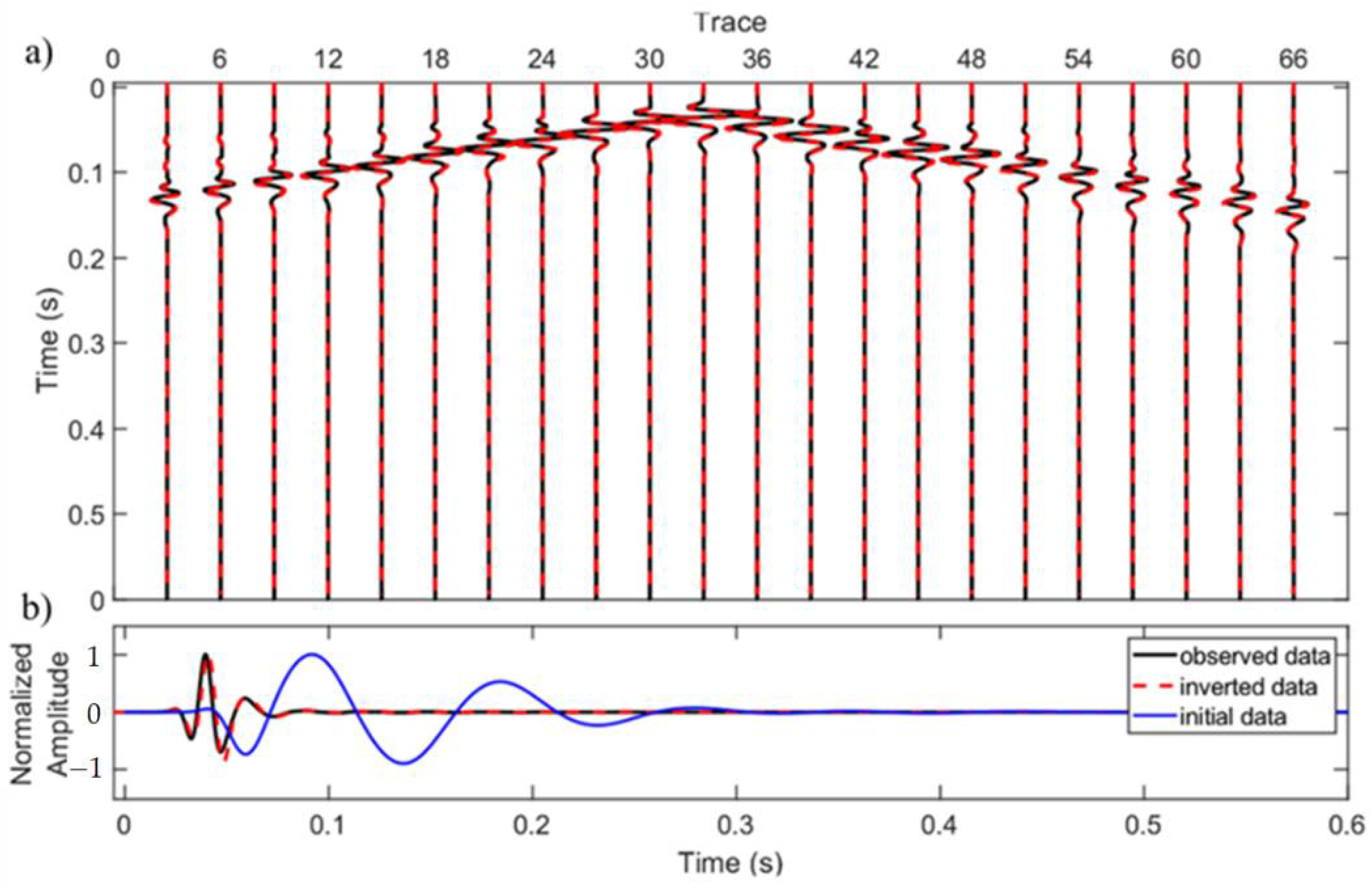
Publisher’s Note: MDPI stays neutral with regard to jurisdictional claims in published maps and institutional affiliations. |
© 2022 by the authors. Licensee MDPI, Basel, Switzerland. This article is an open access article distributed under the terms and conditions of the Creative Commons Attribution (CC BY) license (https://creativecommons.org/licenses/by/4.0/).
Share and Cite
Alaei, N.; Soleimani Monfared, M.; Roshandel Kahoo, A.; Bohlen, T. Seismic Imaging of Complex Velocity Structures by 2D Pseudo-Viscoelastic Time-Domain Full-Waveform Inversion. Appl. Sci. 2022, 12, 7741. https://doi.org/10.3390/app12157741
Alaei N, Soleimani Monfared M, Roshandel Kahoo A, Bohlen T. Seismic Imaging of Complex Velocity Structures by 2D Pseudo-Viscoelastic Time-Domain Full-Waveform Inversion. Applied Sciences. 2022; 12(15):7741. https://doi.org/10.3390/app12157741
Chicago/Turabian StyleAlaei, Niloofar, Mehrdad Soleimani Monfared, Amin Roshandel Kahoo, and Thomas Bohlen. 2022. "Seismic Imaging of Complex Velocity Structures by 2D Pseudo-Viscoelastic Time-Domain Full-Waveform Inversion" Applied Sciences 12, no. 15: 7741. https://doi.org/10.3390/app12157741
APA StyleAlaei, N., Soleimani Monfared, M., Roshandel Kahoo, A., & Bohlen, T. (2022). Seismic Imaging of Complex Velocity Structures by 2D Pseudo-Viscoelastic Time-Domain Full-Waveform Inversion. Applied Sciences, 12(15), 7741. https://doi.org/10.3390/app12157741







